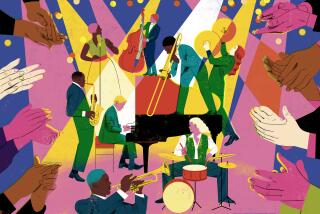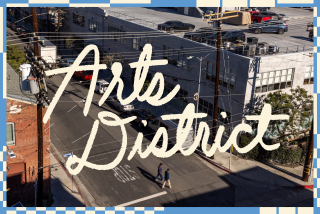In Amsterdam when it sizzles
Amsterdam — When we lived in this city in 1998 and ‘99, we were always out of town for New Year’s Eve. The last week of December, we caught a train to Paris or Bern, Switzerland, pushing against the tide of Brits, French, Germans, Belgians -- seemingly everyone in Europe under 30 -- as they poured into Amsterdam.
Unlike in the United States, where the holiday often calls for private, indoor celebrations, Europeans mark New Year’s Eve by gathering in public spaces, from the Brandenburg Gate to the Bastille to Trafalgar Square. Among these, Amsterdam’s celebration has become legendary, and last December my 18-year-old daughter, Kira, and I came back here to see what we had missed.
Although there were wisps of pink in the iron gray sky, it looked cold outside as our train traveled from Brussels into the Netherlands. Cows grazing in wet fields gave way to houses pressed against one another.
But I lost interest in the passing scenery when a cute blond came aboard at Den Haag. She was 6 years old, decked in bright red corduroy pants and matching boots. Her mother’s gentle cry of restraint, “Louisa! Louisa!” had no effect whatsoever as she methodically punched her unperturbed (and sturdy) younger brother. As our train pulled into Amsterdam’s Centraal Station, she smiled at me charmingly while landing the last few blows.
After checking into the Hotel Acro near the Rijksmuseum in the central city, we meandered toward Van Baerlestraat to see whether we could find a favorite family-run restaurant.
Darkness comes early in wintry Amsterdam. It was a clear night, perfect for -- brrrring ... BRRRRing -- dodging bicyclists and being reminded, sternly, to stay out of their lane. After we were safely anchored on the pedestrian path, we resumed our walk, which took us past the museum’s gardens, sidewalk artists and skaters on an ice rink.
A little farther and there it was: Djanoko Indonesisch Restaurant. Amsterdam is filled with Indonesian restaurants, considered among the best in the world and most offering a rijsttafel, or rice table, a way to savor many Indonesian specialties. A hibachi is set before you, and the parade begins. Dish after dish is brought out, till delicacies crowd your table. Some are spicy, some mild, all intriguingly different: white rice, fried rice, beef, pork, chicken, satay, vegetables, fried coconut, eggs, peanut dishes and a variety of sauces. Prices begin about $15 for 14 items and climb from there.
After such a large meal, it felt good to take another long walk along the city’s quiet canals. We followed Nieuwe Spiegelstraat, the street that stretches from the front of the Rijks. Crooked bridges crossed over canals, the blackness twinkling with the reflection of strings and strings of holiday lights. Below, houseboats were dressed for the holidays with red ribbons and colored lights. Shop windows bulged with antiques and toys, books and clothes. Sounds were so muted that we could hear the lap of the water, the crunch of footsteps, the soft whir of a bike. Too tired even to revisit the cafe (now a wine bar) at the corner of Keizersgracht and Nieuwe Spiegelstraat, we headed back to our hotel for sleep.
On Sunday morning in Amsterdam, there is only one place to be: sipping tea as you read a paper, looking out onto Spui Square from the cozy glass-enclosed porch of Cafe Luxembourg. All the expatriates were here, having picked up their English-language papers at Athenaeum Booksellers across the street. We lucked out and won a prime front-row table facing the square. We nursed steaming cups of hot tea and munched crisp biscotti, feeling lazy as bikes and trams flew past outside.
Not that we were going to waste the day. At Nieuwe Kerk (in nearby Dam Square) there’s always something interesting happening. Last year it was the royal wedding between the crown prince of the Netherlands, Willem-Alexander, and Máxima Zorreguieta, an Argentine. We became privy to all their plans, from the tiered cake to the golden coach, at a special exhibit fondly titled, “Ja, ik wil,” or “Yes, I do.”
Next we wandered to Amsterdam’s Historisch Museum. Kira had never realized that it was originally a civic orphanage and wanted to take a closer look. The museum’s cafe-restaurant caught our eye because it was serving a traditional Dutch winter favorite: erwten soep met stokbrood. For $4, we each got a hearty bowl of pea soup, rich with bites of sausage. With rugged brown bread on the side, it was just the thing to keep us warm on a blustery day.
Earlier I had spotted a sign at a restaurant on Begijnesteeg that promised a wonderful apfelstrudel, and so, for dessert, we wandered in that direction. Freshly made that morning and covered with vanilla sauce, the apple strudel tasted all the better because it was served in a rambling room in a centuries-old building by the handsome son of the house. We chatted with his parents as they geared up for New Year’s Eve.
“If you want to eat tomorrow, you’ll want to make a plan today,” warned the wife, answering the phone yet again, though she had just taken her last reservation. “On New Year’s Eve, every restaurant in Amsterdam is filled.”
For New Year’s Eve we had put ourselves into the hands of our friends the Russells, who were notorious for not planning. I crossed my fingers.
Snap, crackle and pop
The morning of Dec. 31 was cold and wet, perfect for what I had in mind. Poor weather often brings better deals, and I was hoping to find some at the Monday morning flea market known as Noordermarkt.
Despite a light rain, there was a spark of excitement in the air. As I was about to drop a few postcards in a mailbox, a woman warned me not to, saying, “It’s New Year’s Eve,” as if that explained it all. Inside the post office, I learned that some partyers have been known to throw firecrackers through mail slots, and so, on New Year’s Eve, most locals leave mailboxes empty.
Suddenly I heard distant pop pop pops and fizzzzzzles, though they had been there all morning. They would not be legal in the city for several hours -- only from 4 p.m. Dec. 31 to 4 a.m. Jan. 1 are they allowed -- but fireworks were going off all over Amsterdam. With festivities sounding in the air, I worried that Noordermarkt would be canceled.
But when I arrived I saw rows of booths lining the cobbled square behind North Church, or Noorderkerk. A calliope was playing. Furniture, silver, leather, tins, hot egg rolls, carpets, thread, old postcards, all were stacked enticingly in baskets and bins or spread across the ground.
Several happy hours later, laden with bags, Kira and I chanced upon an antique store and cafe that promised “Drinks + Furniture for Thee & hot chocolate.” For 20 minutes we relaxed in the cozy dining area without being noticed. We would have liked a sip of that hot chocolate, but we left without finding anyone to serve us.
Later that day, after visiting the Rembrandts and Vermeers at the Rijks-museum, we stopped at Small Talk, a cafe on Van Baerlestraat that serves wonderful apple pancakes. Often signs in English signal a touristy waste of time, but not here. The place always seems to be filled with Dutch people ordering pannekoeken, which is exactly what I was hungry for.
I asked our waiter how much time an apple pancake would take.
“Two days,” he teased. “You want it? You want to take time? Should I place order?”
It was worth a good bit more than the 25-minute wait. Tender chunks of apple were delicious in a large, thin pancake, sprinkled generously with powdered sugar.
Next we visited Albert Heijn (Holland’s favorite grocery store) across the street, and noticed a good price on French champagne. We stocked up.
That evening, people poured into squares throughout the city, particularly the Dam, Rembrandtplein, Leidseplein and Nieuwmarkt, where the Chinese community puts on a superb fireworks show that can last two hours. In Leidseplein, where we went to meet the Russells, bottle rockets streaked through the air while the Beatles’ “All You Need Is Love” blasted from speakers. The square was one enormous party, complete with lasers, street performers, sparklers, dancing and fire eaters. There were also bottles of champagne being shared with strangers, an Amsterdam tradition.
There were no entry charges, no corporate sponsors and, as far as I could see, no regulations. The police were there only to discourage violence and theft, not to spoil the festivities.
But we had dinner to worry about. As suspected, the Russells had not made reservations. But it pays to be a loyal customer, and their favorite restaurant, Granada, promised to squeeze us in. I don’t know how they jammed another table in for us. The place was packed.
After eating delicious tapas, we ordered paella, which usually requires advance notice. We were the last customers to leave, well past 11.
Outside, the city was sizzling. Bursts of light filled the sky. Firecrackers were going off by the pack. In Leidseplein they were still passing around bottles of champagne. With no official countdown to midnight, no gong, no ball drop, the crescendo seemed to build like a wave; then it held, as revelers checked their watches, realized the year had changed and grabbed someone to kiss.
For Kira, Kim Russell and their friends, the night was young and the party stretched across the city. But for the elder Russells and me, it was time to retreat. As we left the madness behind, a low fog rolled in. We crossed the canals, struck by how, only a few blocks away, the crackle and boom of fireworks could fade and mellow. Even on this rowdy night, the city offered pockets of tranquillity.
The slumbering city
On New Year’s Day, Amsterdam sleeps in. At 11 a.m. Jan. 1, the city was as silent as I have ever seen it. No one stirred. The loud bangs had stopped. The fireworks were finished, leaving black streaks and scorched confetti on the sidewalk. The Pancake Bakery on Prinsengracht was rumored to be the only restaurant open.
Kira and I planned to catch a bus to a friend’s house, but even the bus drivers were missing in action. We waited 50 long, cold minutes before one came.
But this is a city that knows how to recover from a hangover. By evening, trams were running, the streets were clean, shops were open and people were out -- ready to party again, I’m sure.
Carole Christie, a freelance writer, now lives in St. Louis.
More to Read
Sign up for The Wild
We’ll help you find the best places to hike, bike and run, as well as the perfect silent spots for meditation and yoga.
You may occasionally receive promotional content from the Los Angeles Times.






